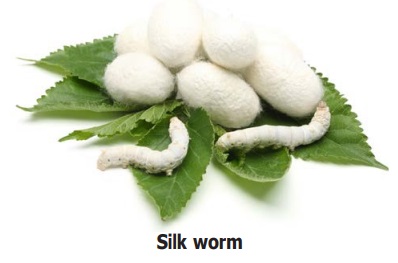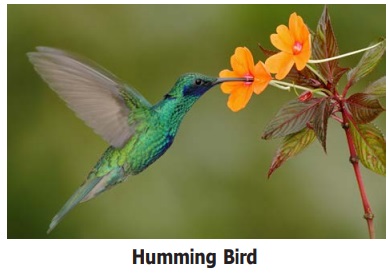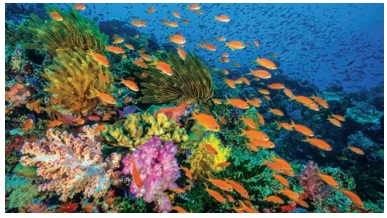Plants in Daily Life | Term 3 Unit 5 | 6th Science - Questions Answers | 6th Science : Term 3 Unit 5 : Plants in Daily Life
Chapter: 6th Science : Term 3 Unit 5 : Plants in Daily Life
Questions Answers
Evalution
I. Choose the
correct answer
1. One of
the following birds is an example of plant pollinator
a. Duck
b. Parrot
c. Humming bird
d. Dove
Answer: c) Humming bird
2. Natural
Mosquito repellant is
a. Nutmag
b. Bamboo
c. Ginger
d. Neem
Answer: d) Neem
3. Which of
the following is not a root ?
a. Potato
b. Carrot
c. Radish
d. Turnip
Answer: a) Potato
4. Which of
the following medicinal plants has anticancer properties?
a. Amla
b. Tulasi
c. Turmeric
d. Aloe
Answer: c) Turmeric
5. Which is
the national tree of India?
a. Neem tree
b. Jack tree
c. Banyan tree
d. Mango tree
Answer: c) Banyan tree
II Fill in the Blanks
1. In every year October 16 is celebrated as world food day.
2. Cotton is an example of textile fibre.
3. I am the state tree of Tamilnadu . Who am I Palmyra palm ?
4. The juice of the leaves of Tulasi plant relieves cough and bronchitis.
5. The edible seeds of leguminous plants are called Pulses.
III. True or
False – If false give the correct answer
1. Plants grown for decorative purposes are
called as softwood.
Plants grown for decorative purposes are called ornamental
plants.
2. Silkworm eats
mulberry leaves.
3. Cauliflower is
used for ornamental purpose.
Cauliflower is cooked and used as food.
4. Cotton cloth is
not suitable for summer season.
Cotton cloth is suitable for summer season as it absorbs
sweat and allows air ventilation.
5. Sugarcane is
used as bio fuel.
Jatropha is used as bio fuel.
IV. Match the following
1. Fibre yield ing plant - Chloramine
2. Hardwood - Spice
3. Neem - Hemp
4. Clove - Cereals
5. Millet – Teakwood
Answer:
1. Fibre yielding plant-
Hemp
2. Hardwood- Teakwood
3. Neem – Chloramine
4. Clove - Spice
5. Millet - Cereals
V. Analogy
1. mango : fruit :: maize : _______
mango : fruit:: maize : seeds
2. coconut : fibre :: rose : ______
coconut:: fibre :: rose : flower
3. bees : pollinate insect :: earthworms:
______
bees : insect pollinator ::
earthworms : tiller of the soil
VI. Give very
short answer
1. What are food plants ?
Plants are the main source of
food for humans. These plants are known as food plants.
2. What are
medicinal plants?
Some of the plants around us are good in healing our diseases. We
call these plants as medicinal plants.
They alleviate bums, cut, cold, fever, sneezes and more.
3. How hard
wood differ from soft wood?
Hardwood is stronger and more durable than softwood. Flowering plants
called angiosperms produce hardwood and non-floweing plants called gymnosperms produce
softwood.
4. What is a
spice?
Spices are aromatic parts of tropical plants traditionally used to
flavour the food. Spices come from the bark or roots of certain plants, leaves,
flowers, or stems of plants. They are primarily used for flavouring, colouring or
preserving food.
Spices used in India
:
Following spices are included in a variety of Indian dishes:
Cardamom, black pepper, curry leaves, fenugreek, fennel, ajwain,
bay leaves, cumin, coriander seeds, turmeric, cloves, ginger, nutmeg, and cinnamon.
5. Name any
three medicinal plants, which are available in your area?
Tulasi, Neem, Aloe.
6. What are
the uses of timber?
The wood needed for the construction of buildings and making of furniture
is obtained from certain plants. We use wood for these purposes due to their features
like durability, stylish finishing and resistance to temperature changes.
VII. Give short answer
1. What is a
symbiotic relationship?
Symbiotic relationship is a special type of interaction between species.
The mutual relationship between plants and animals is an example for symbiotic relationship.
2. Write the
uses of neem?
The leaves of neem are used as mosquito repellent. Moreover they
are used as germicide and disinfectant. Neem oil is used as medicine and fertilizer.
Neem wood is used for making furniture.
3. Name any
five plants and their parts that we eat.
banana – fruit
cauliflower –flower
carrot - root
potato – stem
cabbage - leaves
VIII. Answer in
detail
1 Write short
notes on – Timber yielding plants.
The wood needed for the construction of buildings and making of furniture
is obtained from certain plants. We use wood for these purposes due to their features
like durability, stylish finishing and resistance to temperature changes.
All commercial timbers are classified into two classes as Hardwoods
and softwoods based essentially on their structure.
Hardwoods: Hardwoods are angiosperms (flowering plants), the largest group
of land plants. High-quality furniture, decks, flooring, and wooden construction
are being made only using hardwood. eg. Teak, Jackfruit.
Softwoods : Softwoods come from gymnosperm (non-flowering plants) trees. Certain
angiosperms also yield softwood
Softwoods have a wide range of applications such as making plywood,
wooden boxes, medium-density Fibreboard (MDF) and paper making. eg: Katampu, Pine.
2. Comment on
importance of plant animal interaction.
Animals rely on plants for their food and shelter. This relationship
benefits not only animals but also plants. Such relationship is economically significant.
For example, silkworms feed on mulberry leaves and live on mulberry
plants. This relationship between a worm and a plant is economically useful for
us in silk production.

Animals, pests, and birds are essential for cross-pollination of
plants.
Bright colours of flowers, smell and honey attract insects. As the
insects go from one flower to another, they leave the pollen grains from their body.
This results in cross-pollination and the formation of vegetables and fruits.

These insect pollinators and birds need to be protected to produce
the best yield.
Bees are the best pollinators. They also give us honey.

Plants and algae living in coral reefs are the food for variety of
fishes. Fisheries work is done in these areas.

Animals and birds play an important role in spreading seeds of various
plants. The digestive enzymes in the digestive system of the birds soften the protective
layer of the seeds and make it easier to germinate.
If this natural relationship between animals and plants is affected,
it shows its impact on economy too.
IX. Questions
based on Higher Order Thinking Skills
1. Desert does
not have water. Why? Give the reason.
Deserts do not have lakes, seas or rivers. So evaporation of water,
formation of clouds and precipitation do not take place here. As water is scarce
in deserts we cannot see forests in deserts. The rays of the hot sun hit the earth
directly. As the earth in desert is very hot very little water is available here.
2. Kavitha
said “ Palm tree is a tall tree, so it gives hard wood”! Do you agree with her
statement or not ? Explain Why?
The palm tree is tall but it does not give hardwood. The middle of
the trunk is hollow and soft. So it is not used to make durable wooden furniture.
3. Look at the
diagram given below and answer the following questions.
a. Soil
fertility is increased by bacteria How?

Some kinds of bacteria (like rhizobium) fix atmospheric nitrogen.
The nitrogen fixing bacteria in the root nodules of leguminous plants absorb atmospheric
nitrogen and store it in the nodules. This kind of nitrogen fixation is very useful
for plants.
b. Honey
bees
are essential for the reproduction of the plants Why?

Honeybees visit many flowers in search of nectar. Every time they
visit a flower the pollengrains in the flower stick to the bee. When the honeybee
visits the next flower the pollengrains fall on the stigma of this flower. Thus
cross pollination takes place. This cross pollination results in formation of seeds
and saplings.
Related Topics